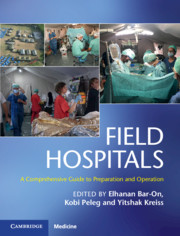Book contents
- Field Hospitals
- Field Hospitals
- Copyright page
- Contents
- Contributors
- Preface
- Section 1 History
- Section 2 Scenarios
- Chapter 3 Definitions, Needs, Scenarios, Functional Concept, and Modes of Deployment
- Chapter 4 Needs Assessment
- Chapter 5 Predeployment Operational Planning and Preparations
- Section 3 Operational Considerations
- Section 4 Clinical Considerations
- Section 5 Additional Contextual Considerations
- Index
- Plate Section (PDF Only)
- References
Chapter 3 - Definitions, Needs, Scenarios, Functional Concept, and Modes of Deployment
from Section 2 - Scenarios
Published online by Cambridge University Press: 09 January 2020
- Field Hospitals
- Field Hospitals
- Copyright page
- Contents
- Contributors
- Preface
- Section 1 History
- Section 2 Scenarios
- Chapter 3 Definitions, Needs, Scenarios, Functional Concept, and Modes of Deployment
- Chapter 4 Needs Assessment
- Chapter 5 Predeployment Operational Planning and Preparations
- Section 3 Operational Considerations
- Section 4 Clinical Considerations
- Section 5 Additional Contextual Considerations
- Index
- Plate Section (PDF Only)
- References
Summary
Past experiences from uncoordinated and inefficient medical responses to disasters have prompted the WHO to formulate a system that includes minimum standards to which responding medical teams must adhere. Three levels of EMTs are identified: type 1 provides primary outpatient care, type 2 provides intermediate inpatient care, while type 3 provides specialized care. Following larger disasters, the affected country may request international EMT assistance. This assistance will be supported by the WHO. The health-care needs, and thus need for EMTs, will vary depending on type, scale of disaster, and the affected country’s vulnerability. A significant part of the EMT workload will be managing the normal burden of disease. A thorough needs assessment is vital for an effective response and should address anticipated health needs (and their variation over time), local resources available, and seek to gain intelligence on other context-specific challenges. EMTs do not function in isolation, but in a health system coordinated by the affected country. Efforts including the WHO EMT minimum standards system that verify international EMTS are important steps to ensure appropriate standards in a multitude of aspects of global disaster response.
Keywords
- Type
- Chapter
- Information
- Field HospitalsA Comprehensive Guide to Preparation and Operation, pp. 17 - 23Publisher: Cambridge University PressPrint publication year: 2020



